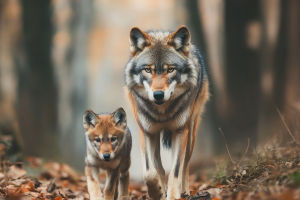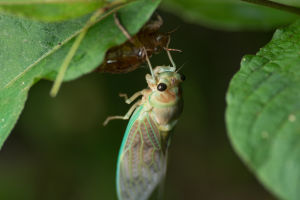Have you ever been outside on a warm summer evening and witnessed the glowing flashes of fireflies lighting up the night? There's something magical about seeing their lights flicker on and off, creating an almost dreamlike atmosphere.
But have you ever wondered what's behind this beautiful light show? Why do fireflies glow? And how do they use their light to communicate with each other?
In this article, we'll dive into the fascinating world of fireflies and explore how they use their glowing abilities, known as bioluminescence, to attract mates and communicate. Let's unravel the mystery behind their nighttime light show!
What is Bioluminescence? The Science Behind the Glow
Bioluminescence is the ability of living organisms to produce light, and fireflies are one of the most well-known examples of this phenomenon. But how do fireflies create this light? It all comes down to a special chemical reaction in their bodies.
Fireflies have special light-producing organs called photocytes located in their abdomens. Inside these cells, a chemical reaction takes place between a substance called luciferin, an enzyme called luciferase, oxygen, and other molecules. When these components combine, they release energy in the form of light.
This light is often referred to as cold light because it doesn't generate much heat, making it an incredibly efficient way to produce light. The glow you see is a result of this chemical reaction happening inside the firefly's body.
Interestingly, not all fireflies use their glow in the same way, and this variation is key to their survival and reproduction.
How Fireflies Use Light to Attract Mates
For fireflies, light isn't just for show—it's their way of communicating with potential mates. Different species of fireflies use specific patterns of flashes to signal to each other, especially during mating season. Male fireflies typically emit a series of flashes, while females respond with a unique pattern of light to indicate their presence and willingness to mate.
This method of attracting mates is very much a species-specific code. For instance, some species have a specific number of flashes or a unique timing to their flashes, which helps distinguish them from other species. A male firefly will wait for a female to respond with the correct pattern, ensuring they are communicating with a potential mate of the same species.
Interestingly, firefly light signals are not just used for attracting mates. In some cases, fireflies also use their glow to deter predators by signaling that they are not a tasty meal. Some species of fireflies, like the Photuris, even mimic the light patterns of other firefly species to lure them in and then prey on them.
The Role of Light in Firefly Communication
While firefly flashes are mostly associated with mating, they serve additional purposes beyond reproduction. These light signals are crucial for fireflies' ability to navigate their environment. The light may help them communicate with other fireflies during the night and also maintain group cohesion.
In species that live in groups, light can help fireflies stay in sync with one another and increase their chances of finding a mate. In some cases, the lights can act as a sort of synchronization mechanism, where groups of fireflies flash their lights in unison. This synchronized flashing has been the subject of research, and it's believed to help maximize the chances of attracting mates by making them more visible.
Moreover, fireflies have also been observed using their glow to mark territory or deter other males from approaching females they are courting. The combination of their flashing patterns and the timing of these flashes makes their communication system highly complex and effective.
The Environmental Impact of Firefly Light Shows
While the firefly's light show may seem like a simple mating display, it also plays a vital role in the broader ecosystem. Fireflies are important pollinators, and their bioluminescent signals can also serve as indicators of healthy ecosystems. Unfortunately, in many parts of the world, firefly populations are declining due to habitat loss, pollution, and light pollution caused by artificial streetlights and urbanization.
This decline is concerning because fireflies are not just enchanting creatures; they are also part of a delicate food web. They serve as food for various animals, including birds and frogs, and their larvae are an important source of food for other animals in the ecosystem. Moreover, firefly populations can act as bioindicators, meaning their presence or absence can give us insight into the health of an environment.
Can We Recreate Firefly Light? The Promise of Bioluminescence
The fascinating world of fireflies has inspired a great deal of scientific research, especially in the field of biotechnology. Scientists are working to understand and replicate the biochemical process that allows fireflies to produce light, with applications in everything from medical imaging to sustainable lighting.
In fact, the potential of bioluminescent technology is vast. Researchers have already engineered bioluminescent plants and are exploring ways to use the glow of fireflies in energy-efficient lighting systems. This could be a game-changer for reducing our reliance on traditional artificial lighting while minimizing energy consumption. Imagine a world where streetlights, signs, and even your own garden glow softly without the need for electricity!
Conclusion: The Fascinating World of Fireflies
Fireflies are not just a beautiful sight in the night sky; they are living wonders with intricate systems of communication and survival. Through their bioluminescent light, they attract mates, navigate their environment, and contribute to the balance of ecosystems. Their glow is a testament to the incredible adaptability of nature and the wonders of evolution.
As we continue to learn more about fireflies, their light may inspire new technologies, and their disappearing glow could remind us of the importance of preserving the delicate ecosystems that sustain them. Next time you see a firefly light up the night, take a moment to appreciate the complex science and the mystery behind their shimmering beauty.
What do you think about the glowing magic of fireflies? Have you ever seen them synchronize their lights in the wild? Let us know your thoughts and experiences in the comments below!


